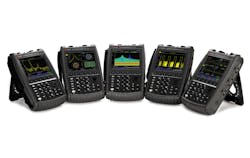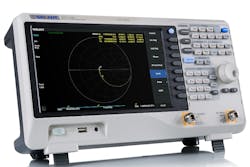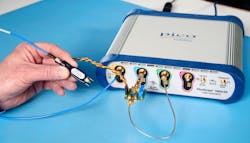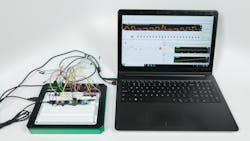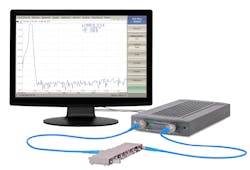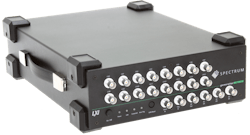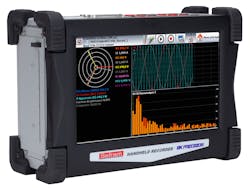Just as landline phones became accompanied by cordless and eventually pocket-sized versions and large desktop computers were accompanied by laptops and then tablets, electronic test instrumentation has also seen a portable revolution over the past couple of decades. Benchtop solutions are still most test engineers’ bread-and-butter when it comes to instrumentation used, and they offer more features compared to their portable counterparts. Still, the natural progression to smaller form factors has resulted in portable instruments that now contain nearly as many test features as benchtop versions from just a few years ago, or even have equal capabilities in some cases.
“Like most other devices we use in our consumer lives, there is a greater demand for longer battery life and lower weight,” Rohde & Schwarz product manager Rich Markley recently told Evaluation Engineering. “Users do not want to lug around a heavy instrument and then have to charge or swap batteries to get a full day of testing in. Another trend is users wanting devices that are not only robust, but also more modern. Bigger, higher-resolution displays that show more information at a glance. Touchscreens that make inputting settings far easier than before. However, they also do not want to give up the ruggedness and in some cases the ability to use the instrument with gloves. So, finding that sweet spot is important for Rohde & Schwarz.”
While wanting ever-smaller form factors, customers want their portable instruments to cutting-edge when it comes to features, along with having the same user interface as benchtop alternatives. It’s quite the challenge for vendors of these products to pack as much as possible into so little space.
Markley elaborated that many end users are frustrated that portable instruments often have limited capabilities compared to their benchtop counterparts. A great example for this is the portable oscilloscopes. Traditionally, portable oscilloscopes have lacked things like higher-resolution ADCs, deep acquisition memory, touchscreens, serial decoding/triggering, fast update rates, a usable FFT, etc. This became generally accepted industrywide, as it was the usual tradeoff.
“More modern, portable oscilloscopes like our R&S Scope Rider do not make users choose,” Markley said. “This is also true in vector network or spectrum analyzers. For example, our new R&S Cable Rider ZPH cable and antenna analyzer is fast to boot, fast to warm up and makes measurements in 0.3 milliseconds per point. This was not something typically possible in handheld instruments before.”
To take a deep dive into this topic of portable instrumentation, we at EE gathered commentary from various vendors of such solutions to get their thoughts on technology trends, challenges, customer demands, and what newer products are on the market. Read on to see what they told us.
What’s trending?
What technology or market trends are vendors seeing in the area of portable instrumentation?
Trevor Smith, business development manager at Pico Technology: “System designers are taking advantage of higher performance ICs to bring more sophisticated and advanced products to market. The ICs themselves have been tested and characterized with ultrahigh-performance laboratory oscilloscopes, priced accordingly, and are out of reach for most engineering budgets. Manufacturers are responding with products that deliver the performance needed to capture and analyze signals that are flowing in the new generation of electronic designs, at affordable prices. Even if the escalating budget pressure created by the constantly increasing cost of high-end lab scopes doesn’t prevent a potential buyer from purchasing new equipment, it may likely limit the number of units available to engineers and potentially slow development if test equipment access is restricted.”
Brian Walker, senior RF design engineer at Copper Mountain Technologies: “We see the need for affordable, miniaturized VNAs that can be embedded into hand-held systems, perhaps for detection at a distance from dangerous chemicals or metallic objects with a particular physical configuration.”
Kai Li, product manager at MEAN WELL USA: “Miniaturization has been an ongoing trend for portable instruments. As a result, internal components are also required to shrink in size, and some components are even shifted to external solutions. This is especially true for power supplies and chargers. On the opposite side of things, the power consumption of portable instruments continues to increase as more functions are implemented. A new trend is the integration of IoT functions and wireless capabilities.”
Kaitlyn Franz, test & measurement product marketing manager at Digilent: “When we look at the portable instruments market, there are two main types of products—PC or USB instruments and handheld instruments. While handheld instruments shave their conveniences—display-on-device and probes-on-device—we are seeing a shift in the availability, use, and innovation in the PC/USB instrument market. Engineers are really taking advantage of the portability of these instruments and companies are reacting by jumping in. This provides a marketplace where innovation and software are critical. More and more of these portable instruments are featuring more than just one instrument in the device. We are seeing more emphasis being put on software maturity, features, and flexibility.”
Oliver Rovini, technical director of Spectrum Instrumentation GmbH: “We see an ongoing trend to higher resolution and higher sampling rates in the portable instruments. The demand to acquire high-frequency signals in the range of MHz and above has been increased over the last years.”
Maureen Lipps, test equipment product manager at Newark: “Wireless technology—5G, IoT, Wi-Fi, Bluetooth, and automotive markets are driving portable wireless instrument development. Increased specialization—Test instruments are branching out beyond traditional roles and responsibilities. Modularity and specialized software are becoming inevitable features in portable testers. Environmental testing—Environment changes, safety concerns, and green engineering are driving demand for portable environmental testing and the addition of environmental testing features with traditional test equipment.”
Jamie Pederson, product marketing manager at BK Precision Corp.: “The market is continuing to move to longer battery life/lower power consumption, expanded measurement capabilities, and touchscreen interface.”
Challenges
What key challenges are portable instrument vendors or their partners facing today?
Dunn, Keysight: “Challenges with marketing a portable combination analyzer are educating the customers about measurement and performance capabilities. The advancements in technology that enable miniaturization also bring along performance capabilities not previously attainable in portable test equipment. A broad understanding of measurement applications that span across more than 20 different types of test equipment is a must; as well as engagement with customers that work in the field to find new test methodologies and applications using a portable analyzer.”
Walker, Copper Mountain Technologies: “The lower cost of ownership has opened up new markets and new opportunities. A successful company must be able to keep up with new applications and be able to support new customers who might not be familiar with the equipment.”
Chonko, SIGLENT: “Portable instruments generally have higher material and design costs because the end product must be easy to carry, have a very legible display (even in direct sunlight), and be easy to use in the field. The designers are trying to balance this performance with battery lifetime (if handheld) and performance at a specific price point, which can prove challenging.”
Li, MEAN WELL: “The key challenges manufacturers of portable instruments are facing include battery capacity and security. As the power consumption of portable instruments increase, the battery is required to contain more juice. Faster charging time and higher charging currents are also required, which results in a shift toward higher power for external adaptors and chargers. Also, as the portable instruments devices are integrated with more intelligent features, they also become more susceptible to cyberattacks, so security is also a key challenge and needs to be carefully considered.
Rovini, Spectrum Instrumentation: “Size always matters. With higher sampling rates, more power is needed and more heat needs to be disposed. This is in opposition to the customers’ demands on smaller instruments.”
Lipps, Newark: “Global competition is forcing manufacturers to cut costs while increasing features and reliability from portable instruments. Increased cost is driving the need for compatibility between devices and additional features, putting added demand from manufacturers on software development and software-defined instrumentation.”
Pederson, BK Precision: “Although many manufacturers are implementing touchscreen technology, not all are equal in the usability. In many cases, the display is too small and difficult to operate, or the user interface is clumsy and not well thought out. B&K Precision has met this challenge by improving the user experience with interactive menus on our large touchscreen for setup, waveform visualization, and analysis.”
What are customers asking for?
What features or innovations are customers asking for in portable instruments?
Chonko, SIGLENT: “We field quite a few requests for 12 VDC input power, especially for instruments that can be used to measure RF spectral output. There are many field tests that are required for broadcast Engineers and having a portable instrument that can run off of the 12 V power of a vehicle is very convenient.”
Smith, Pico Technology: “The most commonly requested new features are addition of new serial protocol decoders. Sometimes it feels like there’s a request for a new decoder every day! We recently added decoders for Manchester and DALI protocols in PicoScope. Manchester isn’t a new protocol itself—it was invented in the 1950s—but it’s well suited to a lot of modern applications, including RFID and IR communications devices, and the DALI lighting control standard for buildings.”
Dunn, Keysight: “Customers are asking for as much capability as possible in a small form factor for field test. New features and innovations will follow the trend of adding features and functionality available in heavy benchtop instruments.”
Franz, Digilent: “We are finding that a lot of our customers are requesting more advanced features that they would typically only find in expensive benchtop equipment, as well as requesting as much flexibility as possible. For example, we’ve recently added histogram—a persistence view to the oscilloscope in the Analog Discovery 2—as well as an entirely new instrument—an impedance analyzer—all based on customer request. We’ve also seen an increase in usage and need for our software development kit, including additions of new languages like Python 3.0 and requiring more of the libraries, like prebuilt decoders for the digital channels.”
Li, MEAN WELL: “Some new features customers are looking for include cloud-based database, real-time monitoring, and smartphone interoperability.”
Rovini, Spectrum Instrumentation: “We see more demand for higher channel counts and mixed mode applications combining analog and digital channels.”
Lipps, Newark: “Customers are asking for increased reliability and accuracy, especially those in the aerospace, military, and medical fields. Customers are requiring less technical know-how to operate handheld test equipment. Customers are asking for increased reliability in the field and factory under hazardous or unpredictable environmental conditions. Customers are requiring increased battery life and lighter-weight equipment.”
Key advancements
As their technology has advanced, portable instruments continue to adopt more functionality previously only available on benchtop solutions—at least in some capacity. What key functions have been added in portable instruments over the past few years, and what key functions may be added over the next few years as technology and form factor continue to advance?
Markley, Rohde & Schwarz: “Probably the most obvious improvement that our users first notice is the large touchscreen display. Users are accustomed to screens everywhere they turn, and having that in Rohde & Schwarz devices is an important, user-friendly feature. The R&S Scope Rider provides a crystal-clear image with a high-resolution capacitive touch color display. However, as mentioned earlier, the advancements go far beyond superficial ergonomics and lead to integrating full-fledged benchtop capabilities into a portable form factor.”
Dunn, Keysight: “Device and component test—cable and antenna tester, time domain reflectometer, full two-port VNA, noise figure analyzer, vector voltmeter, extended range transmission analysis, and tracking generator; Signal analysis—spectrum analyzer, real-time spectrum analyzer, time gating, interference analysis, CW source, channel scanner, analog demodulation (AM/FM), over-the-air measurements in 4G and 5G, I/Q analyzer, pulse measurements with peak power sensor, frequency counter, modulation analysis, and 100 MHz bandwidth; Utilities—GNSS/GPS receiver, DC bias variable voltage source, remote control capability, and security features.”
Chonko, SIGLENT: “One of the cornerstones of SIGLENT’s design philosophy is to provide tools that deliver solutions for the engineer. The base measurements are critical, but what you do with the data is just as important. For example, our SSA and SVA spectrum analyzer lines are very portable at just over 10 lbs., but they have excellent performance and usability, making them ideal for the lab bench or the field. They feature a large bright 10” LCD, user-defined limit lines for masking, multiple marker modes and trace options, as well as broadcast specific measurements like occupied bandwidth, adjacent channel power, and TOI. These measurements are made on-screen and provide the user with instant information that can help them solve the issue.”
Walker, Copper Mountain Technologies: “Post-processing of measured data such as time domain measurement, fixture de-embedding, and time domain gating are very useful features. The ability to make amplifier compression and linearity measurement are also desirable.”
Smith, Pico Technology: “The emerging need for automotive Ethernet debug and analysis tools is a significant challenge for traditional portable oscilloscopes. BroadR-Reach employs PAM-3 full duplex signaling on a single twisted pair line. Separating master-slave & slave-master traffic on the same line has previously required use of a hardware directional coupler, which is intrusive, can cause working systems to fail, and doesn’t deliver a signal to the oscilloscope with best integrity.”
Now on the market
What vendors’ recent introductions in portable instruments, and their key features?
Markley, Rohde & Schwarz: “Rohde & Schwarz has recently expanded its R&S Cable Rider ZPH cable and antenna analyzer portfolio with a two-port model, which combines all of previous instruments and combines additional features into one powerful handheld unit, ideal for use in the field. This adds further support for network infrastructure manufacturers and operators in installing and maintaining the growing number of mobile communications antenna systems. For our R&S Spectrum Rider FPH family, we now offer new base models up to 6 GHz, 13.6 GHz and 26.5 GHz, plus corresponding frequency extensions via software upgrades that now take spectrum analysis capability up to 31 GHz. The R&S Spectrum Rider FPH is a flexible solution for precise measurements in the field and lab at an affordable price and a handy tool for diverse applications, such as verifying signal transmission over 5G, broadcast, radar, and satellite communications links.”
Dunn, Keysight: “Keysight’s FieldFox—the industry’s most versatile portable analyzer—has a new line of future-ready analyzers designed to address the ever-increasing demands of 5G, satellite communications, signal monitoring, and electronic warfare applications. Complex beam sweeping technologies used with radar and EW systems, as well as with 5G control channels, will require wider bandwidths and real-time spectrum analysis tools to capture these intermittent and elusive signals. FieldFox can connect to 89600 VSA software to demodulate 5G NR and LTE-A signals up to 100 MHz; or easily switch to over-the-air (OTA) measurements for 5G and 4G LTE to verify gNB performance. FieldFox operates seamlessly in harsh environments, without compromising accuracy or reliability, and it supports record and playback of I/Q capture that can be analyzed with custom I/Q open architecture solutions.”
Walker, Copper Mountain Technologies: “We recently introduced our M Series VNAs, which are lower cost than the equivalent compact series. Some advanced measurement features were omitted, and the lowest measurement frequency was increased to reduce hardware cost.”
Chonko, SIGLENT: “The SIGLENT SVA1015X was released in 2018, but has just recently had a significant firmware update that has extended its capabilities significantly. The SVA is an instrument that is a spectrum analyzer with tracking generator and VNA in one package. RF and broadcast engineers can use the SVA to monitor transmitters but also test RF components using the VNA, demodulate digital communications including IQ/QAM transmissions, and find faults in cables using the optional distance-to-fault option.”
Smith, Pico Technology: “We just introduced the PicoScope 9400-05 and -16 Sampler Extended Real-Time (SXRTO) PC based oscilloscope with 5 and 16 GHz bandwidths, respectively. SXRTO’s are a new class of portable oscilloscopes that combine the benefits of real-time sampling, equivalent-time sampling and high analog bandwidth.”
Franz, Digilent: “Recently we released an impedance analyzer which plugs into the device and adds an interface for the impedance analyzer instrument. We’ve also recently released the Analog Discovery Studio, which has the same software and instruments as the Analog Discovery 2, but we’ve added some additional power supplies, integrated the BNCs, included options for single-ended and differential instruments, and created a prototyping surface with direct connection to the power supplies that is magnetically swappable between designs.”
Rovini, Spectrum Instrumentation: “Our most recent introduced product is the DN2.656-16, a multi-channel AWG which offers up to 16 channels with 80 MS/s output rate (or 8 channels with 125 MS/s) in a compact and portable mobile LXI instrument.”
Lipps, Newark: “Newark recently introduced the Fluke ii900 Sonic Imager. The ii900 is an ultrasonic leak detection meter used to detect leaks in compressed air, gas and vacuum systems. This sonic imager offers a new way to detect leaks using sound waves. The Fluke ii900 is equipped with an array of 64 digital microphones. The imager determines leaks by discerning the direction from where the sound originates by time delays when sound passes over the array.”
Applications
What unique or novel applications are customers applying portable instruments in?
Markley, Rohde & Schwarz: “We have seen many interesting applications in the automotive and transportation industries, in areas of service and installation maintenance, as well as with the wireless technologies. Our instruments helped the Technical University of Munich (TUM) with their fourth win in the Hyperloop competition. Things like that are truly unique. Other different, novel uses for our latest generation of handhelds, especially the R&S Scope Rider, is something that is constantly showing us we are doing a good job.
“We are also seeing a large number of customers replacing their benchtop oscilloscopes in their labs with handheld instruments because the compromises no longer exist when going with a handheld versus a traditional benchtop instrument. So, users now have a portable, battery-powered unit, with floating and isolated inputs and CAT IV ratings, together with all the benchtop capabilities they have come to expect from Rohde & Schwarz instruments.”
Dunn, Keysight: “The University of Pavia’s SNOWAVE system for detecting avalanches consists of a dual-receiver radar with one transmitter and two receivers, each connected to its own radiator. SNOWAVE simultaneously measures propagation distance, wave speed, and attenuation of the snowpack from its surface. As a result, the system can estimate snow depth, density, and liquid water content at the same time without the use of any other equipment. The university selected Keysight’s FieldFox portable network analyzer as its primary measurement tool. Its innovative and durable design, which includes no fans or vents and a sealed enclosure, makes FieldFox an ideal fit for this application, as it can withstand a hostile environment.”
Walker, Copper Mountain Technologies: “As previously mentioned, small resonant structures can be coupled to chemical, biological, or thermal measurement cells, which allows fast measurement and detection in these realms. A matrix of bio sensors might be coupled to a single resonator such that any triggered bio cell gives a positive reading. A hundred or a thousand different tests could be performed simultaneously.”
Chonko, SIGLENT: “The SIGLENT SVA also has a LAN connection with a web-based remote control application. This allows users with access to the instrument LAN to connect with the instrument from anywhere in the world. From there, they can operate it just as they would from the front panel. A number of wireless microphone and broadcast engineers are using the instrument to remotely monitor music arenas and film/video production sites from their production offices.”
Smith, Pico Technology: “A recent and interesting application is for monitoring and control GSI/FAIR particle accelerator beam in Darmstadt, Germany. FAIR enables scientists to match the temperatures, pressures and densities that occur naturally in stellar explosions and collisions. To do so, they bombard small samples of matter with particles. The collisions, for very short periods of time, create cosmic matter at the tiny impact points. PicoScopes are connected at over 200 points around the accelerator ring and in the experiment target areas. They are programmed in C++ using the PicoScope API, running on Linux servers and conforming to the FESA (Front End Software Architecture). Open source GNURadio software development toolkit is used to switch between time and frequency domains.”
Franz, Digilent: “Some of the most unique or novel applications come from the customizability of our portable instruments. There’s a customer that used the WaveForms SDK to build an entire audio analyzer suite using the Analog Discovery 2, as well as a company (knowm.org) that built a custom adapter to analyze memristors. We’ve also seen customers wanting to adopt the Analog Discovery Studio so that all prototyping work can be standardized around the canvas form factor. Prototypes built into a canvas can be magnetically connected and disconnected from the Analog Discovery Studio when they need to be tested or analyzed and the software configuration can be saved for an optimally efficient workflow.”
For more information
Rohde & Schwarz 1
Rohde & Schwarz 2
Copper Mountain Technologies
Keysight Technologies
SIGLENT TECHNOLOGIES
Pico Technology
Digilent
Spectrum Instrumentation
Newark/Fluke
BK Precision
About the Author




